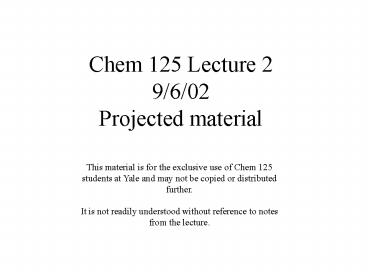Chem 125 Lecture 2 9/6/02 Projected material - PowerPoint PPT Presentation
1 / 28
Title:
Chem 125 Lecture 2 9/6/02 Projected material
Description:
What Lewis Added. Text p. 16 ' ... Vortex Lattice Models (Greg Blonder www.genuineideas.com) ... G. N. Lewis (1923) ... – PowerPoint PPT presentation
Number of Views:13
Avg rating:3.0/5.0
Title: Chem 125 Lecture 2 9/6/02 Projected material
1
Chem 125 Lecture 29/6/02Projected material
This material is for the exclusive use of Chem
125 students at Yale and may not be copied or
distributed further. It is not readily
understood without reference to notes from the
lecture.
2
What Lewis Added
3
Text p. 16
empirical rules for assessing the relative
importance of the resonance structures of
molecules and ions.
1. Resonance structures involve no change in the
positions of nuclei only electron distribution
is involved.
LORE
2. Structures in which all first-row atoms have
filled octets are generally important however,
resulting formal charges and electronegativity
differences can make appropriate nonoctet
structures comparably important.
3. The more important structures are those
involving a minimum of charge separation,
particularly among atoms of comparable
electronegativity. Structures with negative
charges assigned to electronegative atoms may
also be important.
4
Is it True?
Force Laws
5
Levitator by Martin Simon (UCLA)
Eppur sta fermo
6
Earnshaw's Theorem(1839)
In systems governed by inverse-square force
laws there can be no local minimum (or
maximum) of potential energy.
7
Visualizing Earnshaw - Coulomb's Electrostatics
8
Faraday/Davy/Phillips
9
A positive particle has a local maximum or
minimum of energy only at the location of another
charged particle, never in free space.
10
Earnshaw's Theorem
In systems governed by inverse-square force
laws there can be no local minimum (or
maximum) of potential energy.
The only stationary points are saddle points.
11
"I have ever since regarded the cubic octetas
representing essentially the arrangementof
electrons in the atom" G. N. Lewis (1923)
Was Lewis ignorant of Earnshaw's Theorem?
12
J.J. Thomson (1856-1940)
Electron (1897)
13
Thomson's Model of Electron Configuration
"consider the problem as to how 123n
corpuscles would arrange themselves if placed in
a sphere filled with positive electricity of
uniform density"
distributed in the way most amenable to
mathematical calculation
14
Vortex Lattice Models (Greg Blonder
www.genuineideas.com)
15
Thomson's Model of Electron Configuration
"consider the problem as to how 123n
corpuscles would arrange themselves if placed in
a sphere filled with positive electricity of
uniform density"
"the equilibrium of eight corpuscles at the
corners of a cube is unstable."
16
"I have ever since regarded the cubic octetas
representing essentially the arrangementof
electrons in the atom" G. N. Lewis (1923)
Was Lewis ignorant of Earnshaw's Theorem?
17
Conclusion ofValence and the Structure of Atoms
and Molecules G. N. Lewis (1923)
The Future of the Quantum TheoryThe
Discontinuity of Physico-Chemical Processes
"if we use the electron as a test charge to
determine the properties of the simplest possible
electric field, namely, the field about a
hydrogen nucleus, we appear to find that this
field is not a continuum but is strikingly
discontinuous."
18
The Electron in ChemistryJ. J. Thomson (1923)
if electron-nuclear attraction were to vary
strictly as the inverse square of the distance we
know by Earnshaw's theorem than no stable
configuration in which the electrons are at rest
or oscillating about positions of equilibrium is
possible ...
19
Quantum Mechanics (1926)
reformulated kinetic energy to explain electron
clouds and produce an "inverted" plum-pudding
atom.
Cubic octets and ad hoc force laws soon
disappeared from conventional Chemistry and
Physics
But shared-pairs and lone-pairs became useful
tools for discussing structure and bonding.
20
How do you know?
Might there still be shared-pair bonds and lone
pairs?
By Seeing? Feeling?
21
InconceivablySmall?
22
OCCULT CHEMISTRYA SERIES OFClairvoyant
Observations on theChemical ElementsBYANNIE
BESANT, P.T.S.ANDCHARLES W.
LEADBEATERReprinted from the
Theosophist.THEOSOPHIST OFFICE, ADYAR,
MADRAS, S.THEOSOPHICAL PUBLISHING SOCIETY,
LONDON AND BENARES CITY.
1909 (105 pp.) 1919 (123 pp.)
1951 (400 pp.)
23
The Occult Chemists (1895-1932)
24
H O N (1895)
18 290 261
25
Anu
These 42 Aphorisms have inspired more than 100
Commentaries
"Matter exists in the form of indivisible
elementary particles and their combinations"
J. L. Jaini (1920)
"(Matter has 2 chief forms) atom and molecule."
G. R. Jain (1942)
26
Occult Atoms
27
Na2CO3(1924)
"note that this trian-gular arrangement of O3 has
just been deduced by Bragg from his X-ray
analysis of Calcite"
28
Benzene(1924)
"each of the three valencies of each Carbon
are satisfied by Hydrogen, and the fourth
valency, which some have postulated as going to
the interior of the molecule, does actually do
so."































